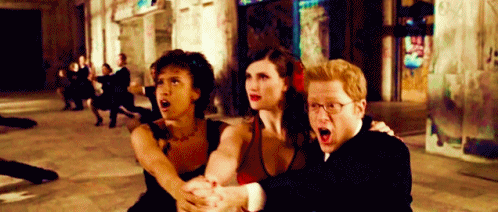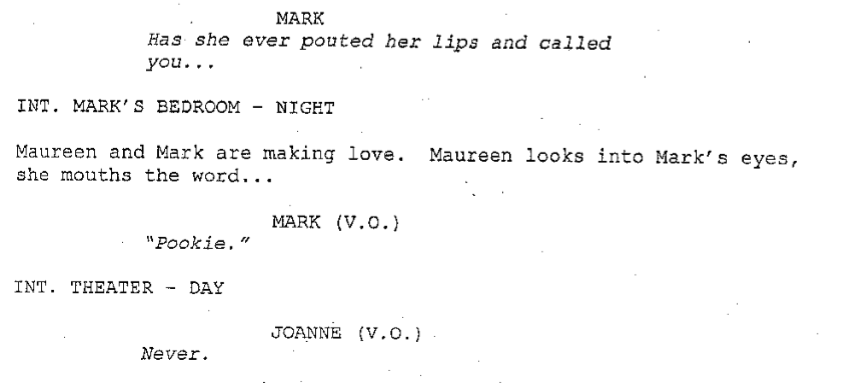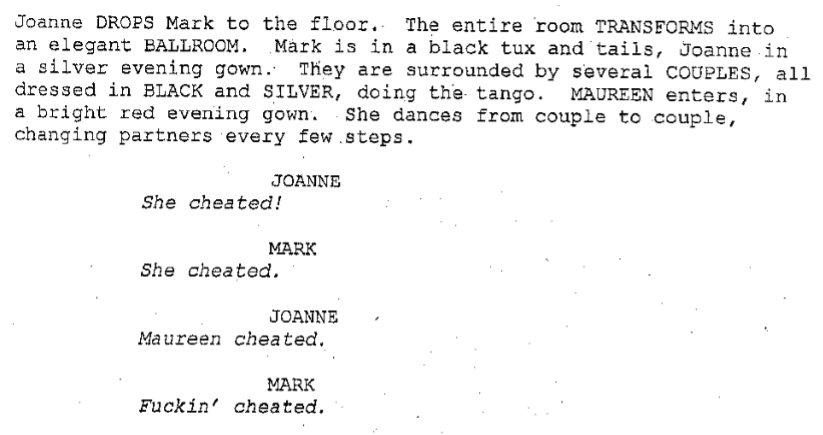Blueprints: "Rent"
 Thursday, June 21, 2018 at 5:11PM
Thursday, June 21, 2018 at 5:11PM To celebrate Pride Month, every week of June Jorge has been highlighting the script of a movie that focuses on a different letter of the LGBT acronym. For “B”, he goes back to the film adaptation of one of the most seminal modern musicals, and dissects a number about our favorite bi heartbreaker.

It’s no surprise that it was astoundingly hard to find a movie to discuss that had an openly bisexual lead or prominently supporting character. Bisexuals have had the most lackluster representation in movies among the LGBT community. Usually bisexuality onscreen is only implied and never openly identified as such. To find a strong bi character, I had to go back to something that wasn’t initially a film, but a theater piece; the theater has always been ahead of films when it comes to LGBT representation.
Even though Jonathan Larson’s Rent has not aged particularly well, it did feature an incredibly diverse cast in race and sexuality; from a trans woman of color to a black lesbian, and from your token white guys to, of course, the bi lady to end all bi ladies: Maureen Johnson...
Let’s take a look at “Tango: Maureen”, the number in which both of Maureen’s exes discuss how she makes people fall in and out of love with her. In particular, let’s see how the script attempted to make the sequence more cinematic, though the film ultimately decided to stick with a theatrical approach.
Rent
Written by: Stephen Chbosky
Based on the musical of the same name by Jonathan Larson
[You can read the whole script here. I will be talking about this scene.]
One of the most memorable aspects of the original staging of Rent is that all of it takes place within the boundaries of a single set made up entirely of scaffolding. It's an iconic element of the show that just wouldn’t work cinematically. The film has to actually take the story out to different locations and, in theory, know how to utilize film language in a way that theater couldn't.
Screenwriter Stephan Chbosky (who later would go on to write hit adaptations like Beauty and the Beast and Wonder, as well as The Perks of Being a Wallflower which was based on his own novel) understands the jump of medium very well in his draft of the screenplay. He tries to bring in cinematic elements like fantasy sequences, jump cuts and change of locations, to translate the numbers to to film rather from stage. Unfortunately, most of these changes actually never made it to the movie.
“Tango: Maureen” is all about Mark (Anthony Rapp) and Joanne (Tracie Thoms) recounting their experiences with Maureen (Idina Menzel), and the insecurities that come up when you're in a relationship with her. To illustrate this, Chbosky adds elements like the insertion of images and scenes of their respective stories that illustrates what's being sung, like Maureen dancing with other people at the club, and the iconic “Pookie” line. He also introduces Maureen in a more direct and dramatic way by starting in tight close-up and then showing her perform an interpretative dance.

***

***

***

However, in the actual film most of the song remains in the warehouse that Mark and Joanne are in, and stays a simple singing conversation with some dancing, much like the stage version. The only moment that the film breaks this reality is when Mark hits his head on the floor, and then suddenly the location transforms into a ballroom, in keeping with the song’s title.
The second half of the sequence in the film actually does stay pretty faithful to Chbosky’s script, keeping in details like the color coding of the costumes and how Maureen changes couples on every dance move. It also ends on the same note of her walking out with a man and a woman on each arm, leaving Mark and Joanne behind.

***

Rent is one of the lesser musical adaptations of recent years, mainly because it lost the spark that made the original stage version so…well, electrifying. It ended up being a leaden copy-and-paste version with larger sets. But as the draft of the script shows, the writer actually intended to change and expand on the world of the musical, and use cinematic elements to make it more visually dynamic.
I cannot say what exactly happened in the end, or why the decisions to cut these elements off and keep them stage-like were made. But Rent remains a well-intentioned though highly forgettable attempt to bring to the screen a story of daylights, of sunsets, of midnights, of cups of coffee…



Reader Comments (8)
Chris Columbus:Rent::Ron Howard:Solo
"Nice Young Men" trying to interpret gritty, sexual material beyond the Missionary Position, and having no idea how to do that.
The problem with "Rent" the movie is that everyone looks too old and healthy for the parts they are playing- the "Tango Irene" number is one the most effective cinematic sequences in the film
A very bad movie. I nearly fell asleep in the theater and a few years later tried to give it a go with a rewatch and nearly fell asleep again. It's like bohemia as interpreted by Old Navy & The Gap.
For bisexual lead, look no further than Tilda Swinton’s American debut: Female Perversions!
Rob wins the comments! 🖤
Everybody Has AIDS!
"Call Me By Your Name" qualifies as a "B" but a lot of people seem to love erasing that one.
"Blue is the Warmest Color" has a bisexual lead :)